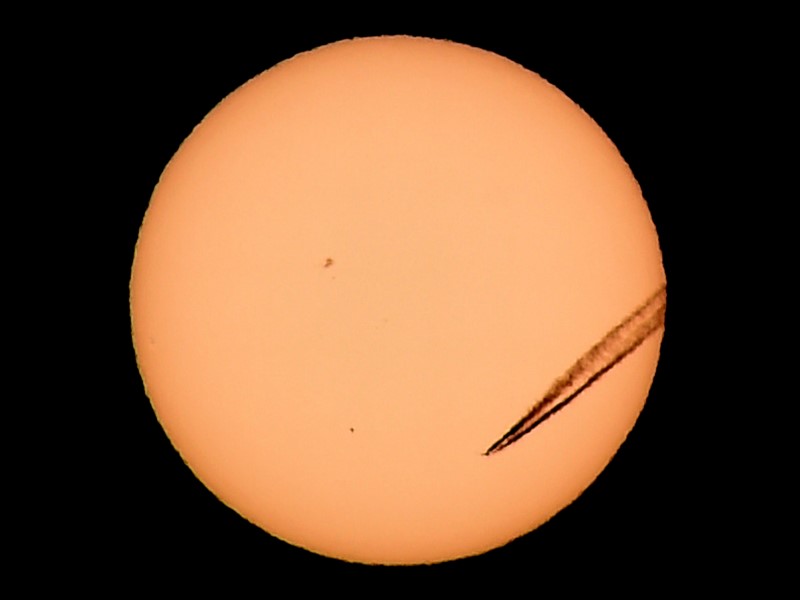- Home
- Science
- Science News
- Earthlings Watch as Tiny Mercury Sails Past the Sun
Earthlings Watch as Tiny Mercury Sails Past the Sun

The journey, which astronomers refer to as a "transit," began with what looked to be a small, black dot on the edge of the sun at 7:12am EDT (11:12am GMT), images relayed live on Nasa TV showed.
Over the next seven and a half hours, Mercury, which travels at a speed of 30 miles (48 km) a second, crossed the face of the sun, a spectacle last seen in 2006.
"It's all about perspective," Nasa planetary sciences chief Jim Green said during a panel discussion aired on Nasa TV.
Mercury's orbit around the sun is more tilted than Earth's so it only rarely appears to cross the sun relative to Earth's line of sight, Green said.
About 13 times a century, Mercury and Earth line up, giving armchair stargazers and professional astronomers a chance to view Mercury as it passes between Earth and the sun.
Monday's transit was the first since Nasa's Messenger mission to Mercury, which orbited the planet from 2011 to 2015. The spacecraft relayed startling details of Mercury's heavily cratered and unexpectedly diverse landscape.
Though temperatures on Mercury's surface reach 800 degrees Fahrenheit (427 degrees Celsius) - hot enough to melt lead - the planet also has deep craters where the sun never shines. These pits, where temperatures rival the coldest places in the solar system, contain frozen water and organic materials.
During Monday's transit, astronomers hope to build on Messenger's findings by learning more about gases vaporizing from the planet's surface. The "out-gassing" may be a factor in why Mercury is shrinking, Green said.
Astronomers also used the transit to calibrate sensors on a trio of space-based solar telescopes and refine techniques to look for planets beyond the solar system.
"When a planet crosses in front of the sun, it causes the sun's brightness to dim. Scientists can measure similar brightness dips from other stars to find planets orbiting them," Nasa said.
Mercury will pass between the sun and Earth again in 2019. After that, the next opportunity to witness the event will not come until 2032.
Catch the latest from the Consumer Electronics Show on Gadgets 360, at our CES 2026 hub.
- Samsung Galaxy Unpacked 2025
- ChatGPT
- Redmi Note 14 Pro+
- iPhone 16
- Apple Vision Pro
- Oneplus 12
- OnePlus Nord CE 3 Lite 5G
- iPhone 13
- Xiaomi 14 Pro
- Oppo Find N3
- Tecno Spark Go (2023)
- Realme V30
- Best Phones Under 25000
- Samsung Galaxy S24 Series
- Cryptocurrency
- iQoo 12
- Samsung Galaxy S24 Ultra
- Giottus
- Samsung Galaxy Z Flip 5
- Apple 'Scary Fast'
- Housefull 5
- GoPro Hero 12 Black Review
- Invincible Season 2
- JioGlass
- HD Ready TV
- Laptop Under 50000
- Smartwatch Under 10000
- Latest Mobile Phones
- Compare Phones
- Honor Win RT
- Honor Win
- Xiaomi 17 Ultra Leica Edition
- Xiaomi 17 Ultra
- Huawei Nova 15
- Huawei Nova 15 Pro
- Huawei Nova 15 Ultra
- OnePlus 15R
- Asus ProArt P16
- MacBook Pro 14-inch (M5, 2025)
- OPPO Pad Air 5
- Huawei MatePad 11.5 (2026)
- Xiaomi Watch 5
- Huawei Watch 10th Anniversary Edition
- Acerpure Nitro Z Series 100-inch QLED TV
- Samsung 43 Inch LED Ultra HD (4K) Smart TV (UA43UE81AFULXL)
- Asus ROG Ally
- Nintendo Switch Lite
- Haier 1.6 Ton 5 Star Inverter Split AC (HSU19G-MZAID5BN-INV)
- Haier 1.6 Ton 5 Star Inverter Split AC (HSU19G-MZAIM5BN-INV)












